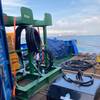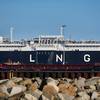Grain Surge Shows Lakes Untapped Potential
According to the Great Lakes Maritime Task Force, Russia’s decision to suspend grain exports has ships throughout the world steering for the Great Lakes to load wheat and other staples. However, the Great Lakes Navigation System has unused capacity and can meet this unexpected demand.
“Grain shipments through the Seaway in September increased 68 percent compared to a year ago,” said James H.I. Weakley, President of Great Lakes Maritime Task Force, the largest labor/management coalition ever to promote waterborne commerce via the Lakes/Seaway system. “The fact that most of these cargos were destined for customers overseas underscores that the Lakes and Seaway truly are America’s Fourth Sea Coast.”
The surge in grain shipments is forecast to last until the St. Lawrence Seaway closes toward the end of December, and then could well resume in the spring.
Weakley, who is also President of Lake Carriers’ Association, noted it is simultaneously fortunate and unthinkable that the Lakes/Seaway system has so much unused capacity. “While we are pleased to be the ‘White Knight’ so to speak, it is just plain wrong that the Fourth Sea Coast is so underutilized. Every one of those extra cargos means not only income for American and Canadian farmers, but jobs for longshoremen, pilots, vessel agents, and all the other men and women who make this system work.”
John D. Baker, GLMTF’s 1st Vice President and President Emeritus of the ILA’s Great Lakes District Council, stressed even this surge is far from pushing the system to its limits. “The Lakes have even more capacity for grain and cargos of all types,” said Baker. “The congestion that more and more plagues our East, West and Gulf Coast ports just doesn’t exist on the Fourth Sea Coast. The maritime community worldwide needs to reacquaint itself with the Lakes and Seaway. Our workers, our docks, and our ports are among the finest in the world.”
The late-season grain surge will place some special demands on the U.S. and Canadian Coast Guards. “The ice season on the Lakes, especially Lake Superior, can begin in early December,” said Gene Caldwell, 2nd Vice President of GLMTF and Vice President and GM of Bay Shipbuilding Co. / Fincantieri Marine Group USA. “Last year the U.S. Coast Guard transferred an icebreaker from the East Coast to the Lakes to keep cargo moving during the ice season. That brought the U.S. Coast Guard icebreaking fleet to a total of nine vessels. The need will be at least as great this year, if not more.”
Canada provided two icebreakers last winter, but one will be in a shipyard this coming ice season. Given that Thunder Bay, Ontario, is the largest single grain-loading port on the Lakes, it is hoped the Canadian government will make more icebreaking assets available.
Full utilization of waterborne commerce on the Lakes/Seaway will also benefit the environment. “A ship can move a ton of cargo more than 600 miles per gallon of fuel,” said Don Cree, 3rd Vice President of GLMTF and National Vice President – Great Lakes, for American Maritime Officers. “In comparison, a train moves a ton of cargo 200 miles per gallon of fuel. A truck travels only 59 miles. Each mode of transportation has a role to play, but clearly, waterborne commerce is the hands-down winner for environmental friendliness.”
Should the need for grain remain strong in the spring, the Seaway usually opens in late March.
Grain is the Lakes’ largest export cargo, more than 12 million tons in a strong year, but iron ore for the steel industry is the system’s mainstay, nearly 70 million tons per year in a strong economy. Coal cargos for power generation can top 40 million tons per year, and combined, shipments of aggregate for the construction industry and fluxstone for steel mills can near 40 million tons.
Founded in 1992, Great Lakes Maritime Task Force promotes domestic and international shipping on the Great Lakes. With 88 members, it is the largest coalition to ever speak for the Great Lakes shipping community and draws its membership from both labor and management representing U.S.-flag vessel operators, shipboard and longshore unions, port authorities, cargo shippers, terminal operators, shipyards, and other Great Lakes interests. Its goals include restoring adequate funding for dredging of Great Lakes deep-draft ports and waterways; construction of a second Poe-sized lock at Sault Ste. Marie, Michigan; protecting the Jones Act and other U.S. maritime cabotage laws and regulations; maximizing the Lakes overseas trade; and opposing exports and/or increased diversions of Great Lakes water.












